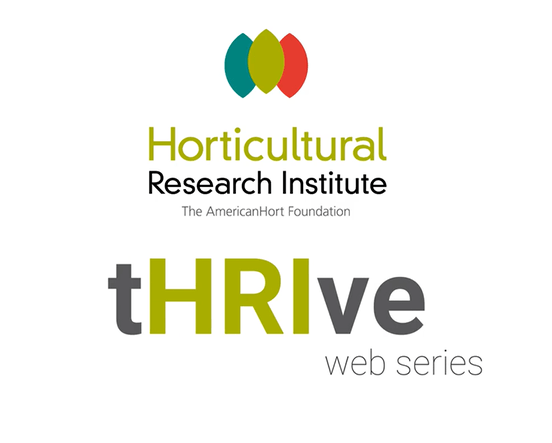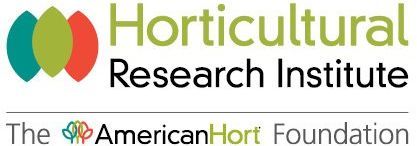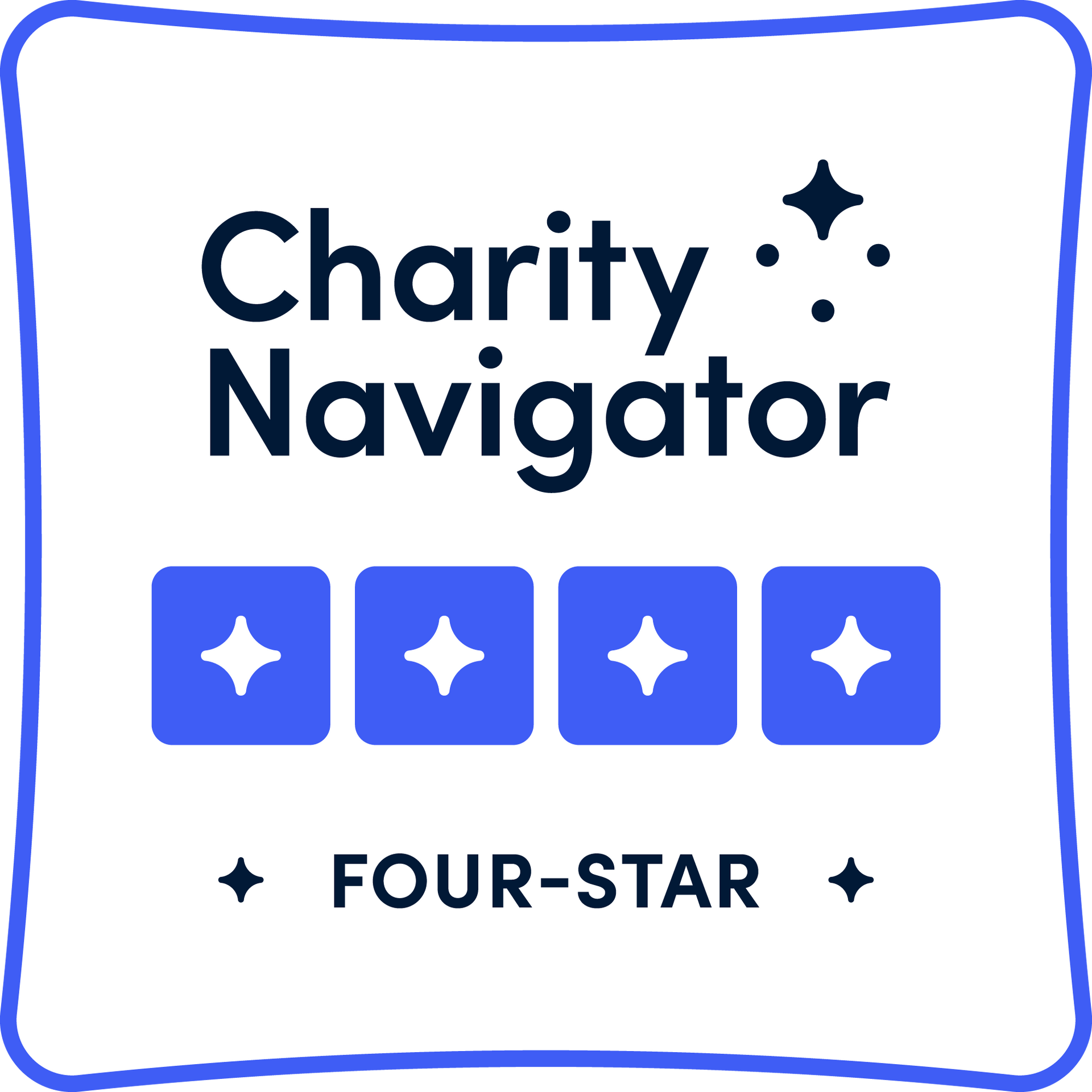Horticultural Research Institute Announces 2019 Funded Research Projects
The Horticultural Research Institute (HRI), the foundation of AmericanHort, is pleased to announce the portfolio of research projects to be funded in 2019. Projects range from innovations to crop production for both greenhouse and nursery segments, water management in landscapes, emergent pest issues, and economic and marketing analyses. A total of $437,200 will be awarded this year.
“The projects funded this year truly represent all facets of the industry,” commented Steve Mostardi, HRI President. “From support of new technological innovations to understanding how consumers buy plants, there’s something in this set of awards that should benefit everyone in environmental horticulture. HRI’s mission is to advance the industry, and the trustees take that to heart when selecting projects to fund. The continuing financial support of individuals and companies from all branches of horticulture, is much appreciated.”
The Horticultural Research Institute’s mission is to direct, fund, promote, and communicate horticulture research. Supporting research that challenges current methods and bridges the divide between businesses and the consumer is exactly how HRI helps build prosperous businesses, advance the green industry, and fulfill its core vision.
Off the sales floor & into the cart: Analyzing the path to plant purchases
Dr. B. Behe, Michigan State University
How do consumers make buying decisions? This project aims to tackle that question about plant purchases. New technologies such as a portable device that tracks eye movement, will be used to investigate visual cue selections that lead to plant purchase. Packaging, in-store signage, brand, and price may impact consumers’ choices. Results should help retailers improve the shopping experience.
Fertility, population dynamics, & pollinator attractiveness of standard & sterile cultivars: Buddleia as the case study may inform the way forward for our national industry
Dr. R. Contreras, Oregon State University
Many in our industry aspire to maintain and promote ecosystem services of plants. The search for plants that are both not weedy or invasive yet are still attractive to pollinators continues. Often pollinator attractiveness is sacrificed to ensure a new introduction has a low risk of becoming invasive. Dr. Contreras and his group aim to develop robust and consistent metrics for evaluating a plant’s potential to be invasive as well as support pollinator services.
Seed your future
Dr. J. Dole, North Carolina State University and S. Yoder, Seed Your Future
Increasing the number of students and graduates in horticulture serves the entire horticultural industry. The Seed Your Future project aims to do just that through promotion of horticulture among young people and in academic settings. Over 150 partners are involved, and HRI is pleased to continue support of this work.
RFID & beyond: Using RFID, drones, and BLE to improve crop inventory management
Dr. R. Fernandez, Michigan State University
Dr. Fernandez and his team take an integrative approach to helping environmental horticulture better manage crop inventory and make production more efficient. Three different technologies will be evaluated, including RFID technology, Bluetooth, and drones, and merged for greatest impact. Ultimately, these technologies can allow traceability of production information to crops from the moment they are tagged until they leave the production facility and beyond. This potentially will improve inventory data accuracy, quality control, irrigation management, and pesticide application.
Fundamental aspects of auxin foliar spray applications to woody plant cuttings
Dr. R. Geneve, University of Kentucky
Applying auxin as a foliar spray has several advantages over traditional quick dip methods for rooting cuttings, such as potential improved worker safety and application efficiency. Foliar auxin sprays are also becoming an integral part of propagation systems using automated, machine-assisted sticking robotics. However, not all woody species respond to foliar spray as well as a quick dip application for rooting, and there are questions concerning application timing as well as the optimal number of applications. Basic questions about auxin movement in cuttings related to spray volume, single vs. multiple applications, and use of a surfactant will be addressed.
National green industry survey
Dr. C. Hall, Texas A&M
This group has conducted the National Green Industry Survey every five years since 1988. Each time, the nursery and greenhouse community reports back on production, management, and marketing practices. This information is important to aid industry members and their allied industries make strategic decisions and continues to serve as a way to monitor changes over time.
Interactions between spotted lanternfly and woody ornamentals that influence tree health and insect fitness
Dr. K. Hoover, Pennsylvania State University
Feeding on more than 65 known species, spotted lanternfly (SLF) poses significant threats to nursery production and landscapes, as well as agricultural commodities. SLF was first found in Pennsylvania in 2014 and has since been sighted in neighboring states and beyond. USDA APHIS is focused primarily on the impacts to agricultural crops, with minor resources dedicated (to date) to environmental horticulture. Movement of SLF in the landscape will be tracked, host tree preference by life stage will be determined. Information learned will help environmental horticulture protect landscape and nursery investments.
Using hyperspectral technology to assess seed quality of horticultural crops
Dr. M. Mesgaran, University of California – Davis
When starting crops from seed, rapid and uniform germination are highly prized. Unfortunately, this is not always the case. Hyperspectral imaging collects information based on a seed’s electromagnetic spectrum, or wavelengths not visible to the human eye. This technology is being evaluated as a quick and nondestructive alternative to time-consuming and costly seed assays.
Boxwood blight management in the landscape
Dr. J. LaMondia, Connecticut Agricultural Experiment Station
Historic gardens and home and commercial landscapes alike fear invasion of boxwood blight. Once plants are infected, the current recommendation calls for plant removal and destruction, followed by a rigorous fungicide program to protect any adjacent, symptom-free boxwoods. Dr. LaMondia plans to focus specifically on management of boxwood blight in landscapes with various fungicides.
Measurement of plant nitrogen status in floriculture and nursery production using smartphones
Dr. K. Nemali, Purdue University
Smartphones have revolutionized the way we find information, like monitoring the weather and remotely adjusting your heating and lighting systems. Wouldn’t it be great to add measurement of your crop’s nitrogen needs to the list? This tool could help enable timely decisions about fertilizer needs in production by bypassing the need for lab analysis (that could take up to 7 days), all the while saving costs and labor.
Landscape plant performance: water use assessments of new cultivar selections
Dr. L. Oki, University of California – Davis
Sound science will be employed to quantify and validate water use claims of certain plants. The data generated will enable the industry to better position certain plants as being verifiably drought tolerant or low water use. Landscape managers and nursery producers in states that experience periodic drought conditions, such as California, Texas, Georgia, and Florida, will benefit most from this study.
Defying gravity: Stratified growing media to reduce inputs, crop stress, and minimize time to market
Dr. J. Owen, Virginia Tech
Have you considered layering two different media substrates? Preliminary studies conducted by Dr. Owen have shown that creating stratified layers of different growing media can help reduce water and nutrient use, all while improving growth and reducing production time. The benefits will be more closely analyzed. As an added bonus, automated container filling systems can be adjusted to create the layers with ease.
Submist for propagation of nursery crops by stem cuttings
Dr. B. Peterson, University of Maine
Propagation is a major component of production in environmental horticulture. Overhead mist systems are quite common but use large volumes of water and create environments ideal for disease. In contrast, a submist system could eliminate these shortcomings and perhaps even expand the range of taxa that can be propagated from stem cuttings. Submist will be compared to overhead systems in terms of cost of construction, operating cost per cutting, and water use per cutting.
Preventing clogging of irrigation emitters caused by algae in greenhouse and nursery
Dr. R. Raudales, University of Connecticut
Clogging of irrigation main pipes and emitters is a persistent problem in both greenhouse and nursery production. One greenhouse operation reportedly dedicated over 13,000 man-hours to inspect, clean, and replace clogged emitters, filters, and irrigation lines in one calendar year. Caused by algae, the biofilm responsible for creating this problem is difficult to manage. Control products exist but could potentially damage crops. As an alternative, manipulation of the irrigation system will be studied as a means to control the biofilm.
Increasing inventory management efficiency with automation for ornamental nurseries & Christmas tree farms using unmanned aerial systems
Dr. M. Wallhead, University of Maine
Labor comprises a large percentage of production costs within environmental horticulture; therefore, technologies that reduce labor costs and increase production efficiency are needed. Automation offers growers the ability to reduce labor and production costs, while increasing production efficiency. In this study, improvements in inventory management using drones fitted with cameras capable of counting trees, tracking tree location and size, and determining tree health status will be assessed.
###
The Horticultural Research Institute (HRI), founded in 1962, has provided more than $7.5 million in funds to research projects covering a broad range of production, environmental, and business issues important to the green industry. Nearly $11 million is committed to the endowment by individuals, corporations, and associations. For more information about HRI, its grant-funded research, or programming, visit www.hriresearch.org or contact Jennifer Gray at 614.884.1155.
Share This Post






